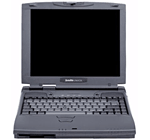frank at fejes dot net


This page is a few years old and I am no longer using this laptop. I just recently began using the Sony Vaio R505-JL SuperSlim notebook (RedHat 7.3) and the Apple iBook (Debian 3.0) with Linux and, prior to that, ran NetBSD 1.5.2 for a good six months or so on the 2060CDS. However, this info is still valid so I'll leave it up for people who might need it. Please be aware that I probably will not be able to assist you with any problems, though.
The inexpensive Toshiba 2060CDS portable computer should offer plenty of power and fun for all but the most demanding applications. Some of the features include:
Installation was not quite as painless as I had expected. I decided to go with RedHat 6.0, however the installation script could never get past the attempt to either create the bootdisk or setup lilo. It simply kept popping up the same dialog and would not allow me to skip the problematic step. After three attempted installs I grew tired of that and pulled out the RedHat 5.2 media and installed it.
Things looked good until the first boot, at which point the system hung upon executing the pcmcia boot script. A boot to single user allowed me to get rid of the pcmcia boot script for the time being. Installing the latest pcmcia distribution and rebuilding the (2.0.36) kernel did not solve the problem. The last recourse was to grab a 2.2.x kernel (2.2.9, in this case) and build it. No problems and the system was ready to go.
The next step was to get XFree86 up and running. The chipset is an S3 Virge MX and makes use of the SVGA server. The fact that Toshiba of Germany notes it as supported and even provides a sample XF86Config file reassured me. However, simple plug and play was not meant to be. Upon bringing up X things look ok, however any window dragging or text output causes massive black static to be thrown all over the screen.
The fix for me was to throw in a
Option "noaccel"and bump down the first Modeline parameter. Everything is peachy now although having anything saying "noaccel" in my configuration does not make me feel too good. :) Also, when using the Toshiba "Resume" (see more below in the apm section) feature, the display has all sorts of troubles and the only way I have found to fix it is to quit X and come back. So, I always make sure to switch to a virtual console (ctrl-alt-F1) before I power down my Resume-enabled machine.
UPDATE: With the assistance of David Reviejo I now no longer am using the noaccel option! The new XF86Config makes available the quick fix for display corruption, either when starting up or when using "Resume". Simply switch resolutions (ctrl alt +/-) and all will be well. Obviously, this also configures two resolution settings, thereby allowing 1024x768 on external monitors and 800x600 on the LCD.
Anyway, hopefully future versions of the server will not require the quick fix and will handle everything well to begin with, but for now I'm content.
Here is the XF86Config.
By the way, I have also upgraded to XFree86 3.3.5.
As with most Toshibi, APM control is in the BIOS (tap ESC when booting) and it works very well with linux. The only disappointment is that "Hibernation" only works from the Windows side of things. "Resume" seems to be the best that we have. Both Hibernation and Resume allow you to power down and then later start up again in place. The difference is that Hibernation writes out to disk and Resume just keeps it in memory. Obviously, the Resume requires power to the RAM, so that means you cannot leave your unattended machine in Resume mode indefinitely or the battery will run out and your system will, basically, crash.
Everything has been working well on the pcmcia front since the installation issues were worked out. Currently I am using a LinkSys 10 Base-T ethernet adapter and it works like a charm. As an added bonus, pulling out the card while NFS filesystems are mounted no longer hangs my system as it did on my past laptop, an IBM ThinkPad 760XL. That's always a good thing.
While sound support for the 2060 has been lacking in the past, we now have it thanks to zab@redhat.com and his ESS Maestro module. Simply download the source for the driver and build it as per his instructions and all will be well. Just make sure that you already have built and installed the kernel's base sound support module.
The 2060 ships with an integrated winmodem. Just recently, Rob Kennedy informed me that Lucent has announced a binary-only kernel module that will provide support for their PCI LT Winmodems. I have tested it and it seems to work pretty well!
Toshiba
Germany's Unsupported Linux Support Page
Linux on
Laptops
Linux
PCMCIA Information
ESS Maestro Driver
Rob Kennedy's 2065CDS Page
Frank S. Fejes III
frank at fejes dot net
last modified: 2003-02-20
home